|
San Diego City and County Historic Designations
By Ann Jarmusch
September/October 2023
At the July 2023 meeting of the City of San Diego Historical Resources Board, members considered the La Jolla Park Coastal Historic District nomination to the National Register of Historic Places, and recommended that it advance to the California State Historical Resources Commission. The commission, meeting in Sacramento in August, unanimously agreed that the 8-acre La Jolla Park Coastal Historic District is eligible for listing in the National Register and forwarded the nomination report to the keeper of the National Register in Washington, D.C. for final processing. The boundaries of the district are based on an 1887 map of La Jolla Park, as it was then called. Lot sales began that year, quickly leading to development of the now internationally renowned jewel that attracts artists, tourists, and residents. The district hugs 2.5 miles of meandering coastline from Torrey Pines Road and Coast Walk at the north end to almost the south terminus of Coast Boulevard. It includes natural landmarks, and historic architectural landmarks and landscape elements. Among these are the Cove, Children’s Pool, Red Roost and Red Rest cottages, the Cave Store and sea caves, 90-foot palm trees, and private homes. Bruce Coons, SOHO’s executive director, voiced SOHO’s strong support for the nomination.
Opponent groups argued that the district could bring harmful effects to the sea lions and harbor seals who haul up along the La Jolla coast. These groups heard reassurances from state and city preservation officials that the National Register historic district would not supersede local, state, and federal marine wildlife or ocean protections.
Also at the HRB’s July meeting, Coons and another speaker urged the board and city preservation staff to get involved in protecting the Spanish Presidio (1769) and its valuable archeological elements and cultural landscape. Coons seconded Presidio Heritage Trust archaeologist Paul G. Chase’s strong call for the city to recognize Presidio Park, a National Historic Landmark, as its “premier monument for international tourism.” Both advocated for the city to conduct an Environmental Impact Report, rather than a less strict Mitigated Negative Declaration, for the so-called ADA project in Presidio Park. HRB chair Tim Hutter asked how the city made its stated choice to bypass an EIR and why the HRB hadn’t been consulted on the project. Hearing that no site development permit was required, he seemed skeptical and asked staff to request that the project come before the board. Board member Courtney Coyle, chair of the HRB’s subcommittee on Archaeological and Tribal Cultural Resources, said it too should look into the Presidio ADA project.
Coons also asked the board to investigate how the century-old, city-owned Balboa Theatre was recently repainted in non-historic colors by a tenant organization and to prevent this error from happening again.
Staff gave an update on the status of what had the appearance of an orchestrated slew of recent designation appeals. Appeals of two designations were later withdrawn, and no appeals followed the June meeting. Still pending are three appeals of April designations: the Donald and Gladys Clitsome/Lloyd Ruocco House; Mamie and Oliver Evans/William Templeton Johnson House; and Fred Rohr/Ralph L. Frank House.
The board designated two homes, described below. For information only, they heard the Historic Preservation Component of the University Community Plan Update.
|
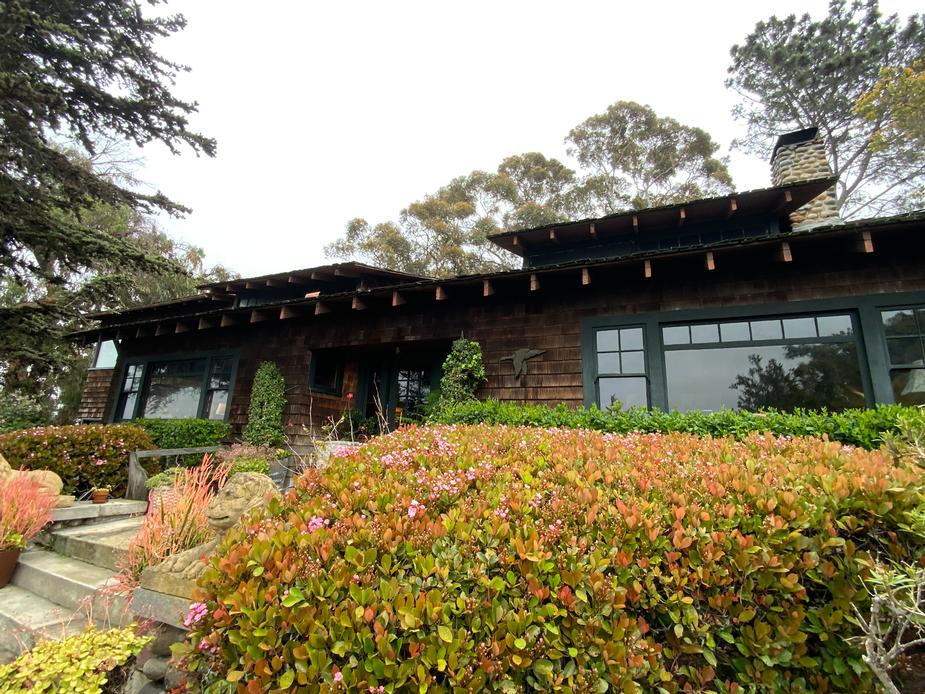 1570 Virginia Way, La Jolla, is the c. 1911 Helmhurst Cottage, designated as an early example of a one-story, small La Jolla beach cottage. Its typical characteristics include a low-pitched roof, wood shingle siding, and orientation toward a coastal view, which is enhanced here by a steep hillside site above Torrey Pines Road. The home meets HRB Criterion A, as part of the La Jolla community’s development and is one of a dwindling number of remaining beach cottages. 1570 Virginia Way, La Jolla, is the c. 1911 Helmhurst Cottage, designated as an early example of a one-story, small La Jolla beach cottage. Its typical characteristics include a low-pitched roof, wood shingle siding, and orientation toward a coastal view, which is enhanced here by a steep hillside site above Torrey Pines Road. The home meets HRB Criterion A, as part of the La Jolla community’s development and is one of a dwindling number of remaining beach cottages.
|
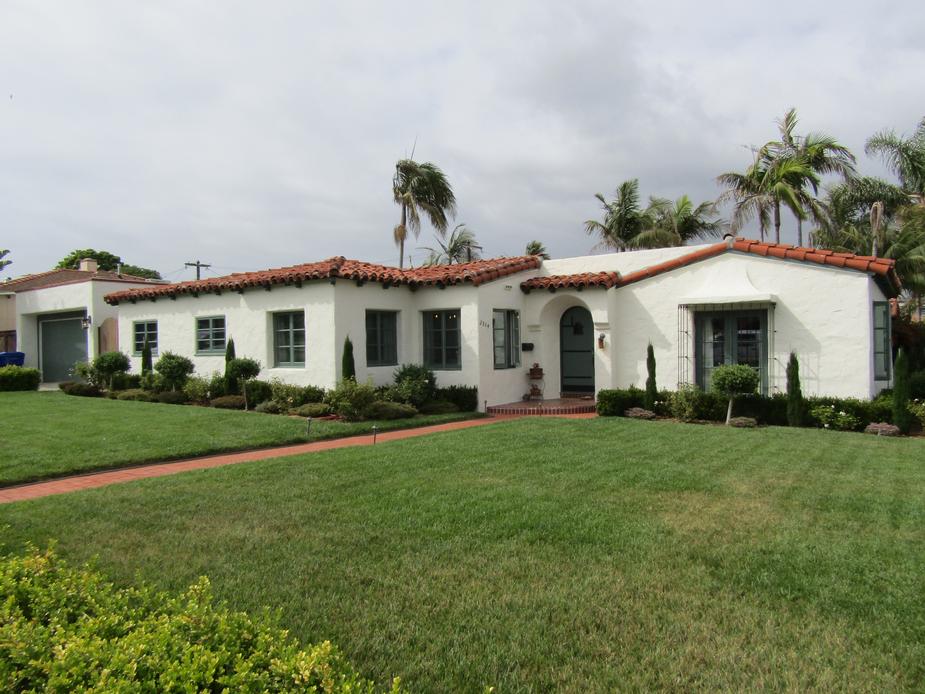 2304 Plum Street, Peninsula Community, is a one-story Spanish Colonial Revival style home built in 1928. Called the Ernest and Ida Cushman Speculation House, it meets HRB Criterion C, for embodying character-defining features of the style and architectural integrity. The house features, among other historic elements, an asymmetrical facade; a deep recessed, arched front entry with a wooden plank style door; deep inset wood casement windows; a combination of roof forms, including flat, hipped, shed, and faux gable; mission half-barrel tile roof; decorative rafter tails; and a hand-troweled stucco cladding with sand finish. The designation includes the original garage. The designation excludes the 2019 pergola structure in the rear yard. 2304 Plum Street, Peninsula Community, is a one-story Spanish Colonial Revival style home built in 1928. Called the Ernest and Ida Cushman Speculation House, it meets HRB Criterion C, for embodying character-defining features of the style and architectural integrity. The house features, among other historic elements, an asymmetrical facade; a deep recessed, arched front entry with a wooden plank style door; deep inset wood casement windows; a combination of roof forms, including flat, hipped, shed, and faux gable; mission half-barrel tile roof; decorative rafter tails; and a hand-troweled stucco cladding with sand finish. The designation includes the original garage. The designation excludes the 2019 pergola structure in the rear yard.
|
At their August 2023 meeting, the HRB heard comments from Barry Hager, an attorney and SOHO member, on streamlining the processing of historic districts that are nominated by local groups for California landmarking and the National Register of Historic Places. Hager offered drafts of documents the city and HRB could use to help decrease hurdles and long wait times. A receptive board said his comments and drafts will be considered first by its Policy Subcommittee.
The HRB designated two homes, and designated and reclassified another in a historic district.
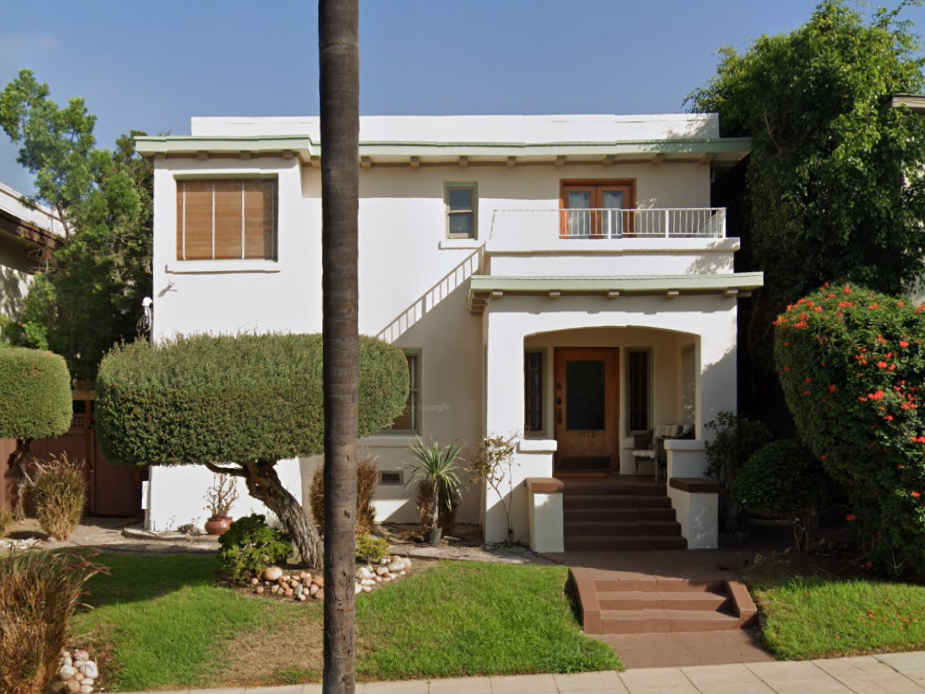 2412 A Street, Golden Hill, is a 1912 Prairie Style house. Because of a misguided addition of a second-story enclosed porch on top of the flat roof that protects the recessed main entry, the two-story home was deemed a non-contributing structure when the city formed the Greater Golden Hill Historic District. The current owner conferred with HRB staff for guidance in removing the enclosure, and restoring the facade and its original stucco finish. Approving the changes that authentically turned back time, the board designated the house under HRB Criterion F—a contributor to a historic district. Courtesy Google street view 2412 A Street, Golden Hill, is a 1912 Prairie Style house. Because of a misguided addition of a second-story enclosed porch on top of the flat roof that protects the recessed main entry, the two-story home was deemed a non-contributing structure when the city formed the Greater Golden Hill Historic District. The current owner conferred with HRB staff for guidance in removing the enclosure, and restoring the facade and its original stucco finish. Approving the changes that authentically turned back time, the board designated the house under HRB Criterion F—a contributor to a historic district. Courtesy Google street view
|
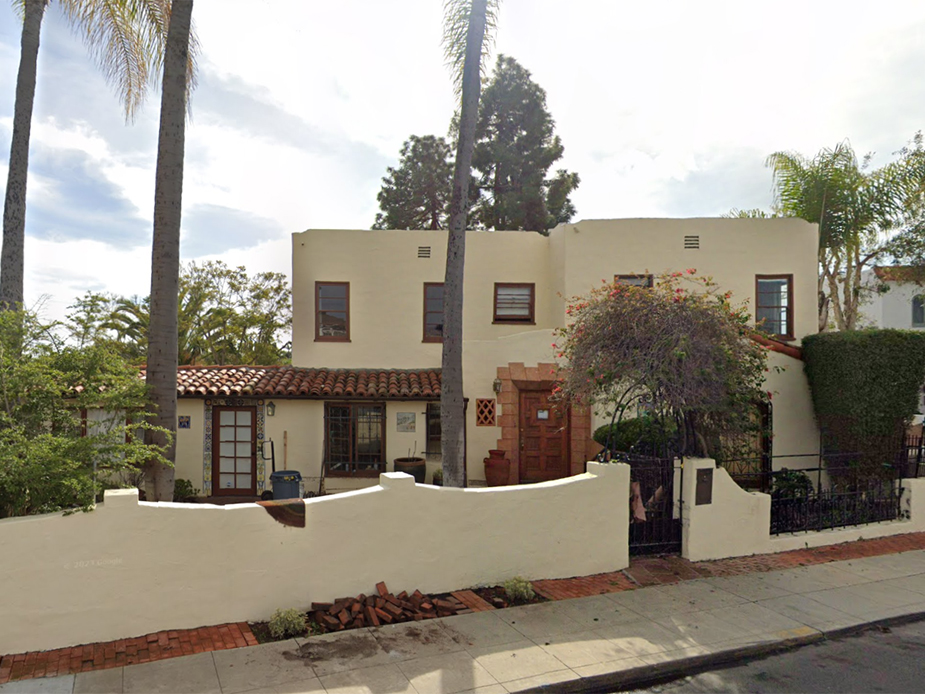 4321 Alder Drive, in the Kensington-Talmadge community, is named the Velma and E.H. Prichard Spec House #1, but this Spanish Colonial Revival style home attracted prominent Mexican owners, including former Mexican president Pascual Ortiz Rubio and Dr. Manuel Maria Doria de la Llata Jr. In 1933, Dr. Doria commissioned Mexican artist Ignacio Martínez Rendón to paint four murals, the wood ceiling, and rafters in an enclosed breezeway, all included in the designation. With a period of significance of 1928-1939, the house exemplifies the Spanish Colonial Revival style with its asymmetrical primary facade, main entry with decorative quoining and paneled wood door, courtyard, stucco exterior, red tile roof, arched focal window, wood-framed windows, majolica tiles, and decorative grilles and iron work. Special handcrafted or painted artistic elements showcase high craftsmanship and design that retain a good level of architectural integrity. The designation includes the cobblestone walls of the rear landscaped terrace, where the property descends into a canyon. The designation excludes the storage cabinets below the south patio. Courtesy Google street view 4321 Alder Drive, in the Kensington-Talmadge community, is named the Velma and E.H. Prichard Spec House #1, but this Spanish Colonial Revival style home attracted prominent Mexican owners, including former Mexican president Pascual Ortiz Rubio and Dr. Manuel Maria Doria de la Llata Jr. In 1933, Dr. Doria commissioned Mexican artist Ignacio Martínez Rendón to paint four murals, the wood ceiling, and rafters in an enclosed breezeway, all included in the designation. With a period of significance of 1928-1939, the house exemplifies the Spanish Colonial Revival style with its asymmetrical primary facade, main entry with decorative quoining and paneled wood door, courtyard, stucco exterior, red tile roof, arched focal window, wood-framed windows, majolica tiles, and decorative grilles and iron work. Special handcrafted or painted artistic elements showcase high craftsmanship and design that retain a good level of architectural integrity. The designation includes the cobblestone walls of the rear landscaped terrace, where the property descends into a canyon. The designation excludes the storage cabinets below the south patio. Courtesy Google street view
|
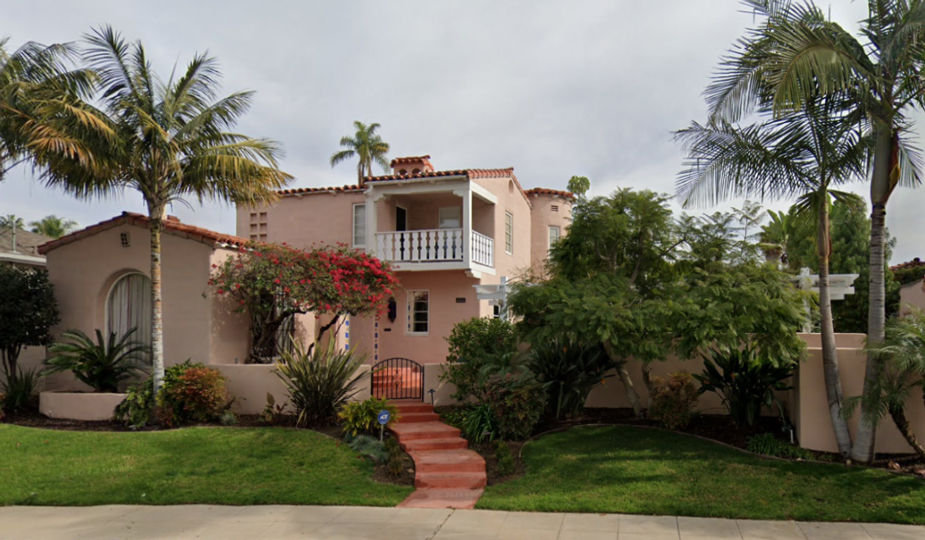 4609 Norma Drive, in the Kensington-Talmadge Community, is a Spanish Colonial Revival home built in 1931 that is now called the Larry Himmel/Dennstedt Company House. It qualifies for designation under three HRB Criteria. From 1977 to 1986, it was the primary residence of Himmel, a popular San Diego reporter and TV personality who won multiple Emmy Awards for his features on San Diego people, neighborhoods, and icons. After the 1999 Columbine shooting, Himmel co-created an award-winning violence-prevention program for schools. He was also a philanthropist who championed Rady Children’s Hospital, Ronald McDonald House, the Alzheimer’s Association, and other charities. His accomplishments meet Criterion B, for a notable resident significant in local, state, or national history. Not a part of the designation, but worth noting, Larry was a true friend to SOHO and a staunch supporter of historic preservation. 4609 Norma Drive, in the Kensington-Talmadge Community, is a Spanish Colonial Revival home built in 1931 that is now called the Larry Himmel/Dennstedt Company House. It qualifies for designation under three HRB Criteria. From 1977 to 1986, it was the primary residence of Himmel, a popular San Diego reporter and TV personality who won multiple Emmy Awards for his features on San Diego people, neighborhoods, and icons. After the 1999 Columbine shooting, Himmel co-created an award-winning violence-prevention program for schools. He was also a philanthropist who championed Rady Children’s Hospital, Ronald McDonald House, the Alzheimer’s Association, and other charities. His accomplishments meet Criterion B, for a notable resident significant in local, state, or national history. Not a part of the designation, but worth noting, Larry was a true friend to SOHO and a staunch supporter of historic preservation.
The home itself embodies and retains characteristics of the Spanish Colonial Revival style (Criterion C), such as an arched entry decorated with tiles; mission half-barrel tile roof; a second-story corner balcony with a wood plank style balustrade; exposed beams; a decorative chimney, and a stucco finish mixed with sand. The home’s most unusual design element may be its cantilevered turret with a funnel-shaped base and conical tile roof. The Dennstedt Company, led by brothers who designed and built this and many other outstanding homes in San Diego, meets Criterion D, for master builder. Courtesy Google street view
|
All photos are from the California Historical Resources Inventory Database (CHRID), except where noted otherwise. The above designations were reviewed and approved by the City of San Diego Historical Resources Board (HRB), the County of San Diego Historic Site Board (HSB), or the Coronado Historic Resources Commission.
|
2025
2024
2023
2022
2021
2020
2019
2018
2017
2016
2015
|








